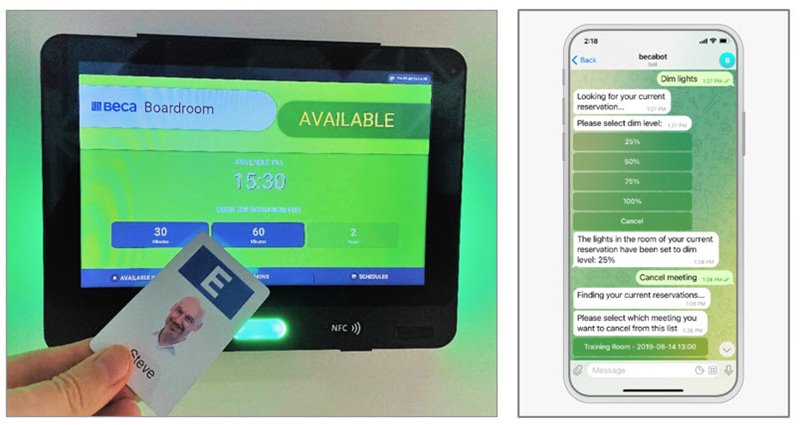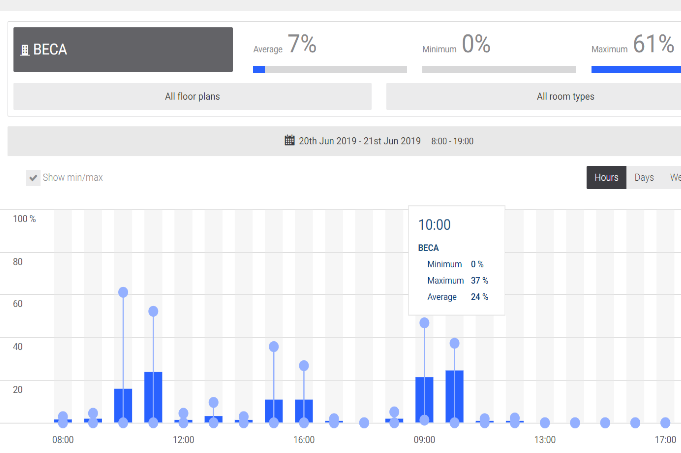With the use of technology, our clients do incredible things every day and Beca are right there beside them. Our Buildings team works with developers, operators and tenants to deliver tomorrow’s built environment. These clients rely on us to advise them on emerging building digital technologies that best fit their needs, so their people benefit from a healthy, comfortable working environment.
Buildings are changing from just dumb boxes that we inhabit, to intelligent environments that automatically adapt to our needs and teach us the best ways to operate them. New digital building technologies are allowing building owners to increase their operational efficiency, improve user productivity and comfort, whilst expanding the range of services they can offer to all their users.There are a vast range of Smart Buildings systems available in the market today, and as trusted advisors to our clients, our ability to separate technologies that provide value from just shiny toys is critical. To gain these insights we continuously engage with the research and development teams of leading technology vendors, observe these solutions in operation through building study tours, and then adopt emerging technologies in our own office so that we can walk a mile in our client’s shoes.
Beca’s Singapore Digital Innovation Hub: A living lab
In our Singapore Office we operate a Digital Innovation Hub (DIH), which allows us to road test a range of technologies including augmented and virtual reality systems, Internet of Things (IoT) sensors and indoor environmental quality monitors. In this sand box environment, we can collaborate with technology industry leaders to truly understand tomorrow’s smart buildings solutions, as both a user and consultant.
Our clients had been asking for smart lighting solutions in their buildings, and we wanted to road-test one in our DIH and large meeting rooms to understand their strengths, shortfalls and required safeguards. In this instance, we partnered with Signify to test and deploy their Interact Office smart lighting system and Getronics for the room-booking and environmental space control chatbot.
We replaced the DIH’s space lighting with Signify smart LED luminaires, each of which has an imbedded Internet of Things sensor bundle. We did a similar replacement in our Board Room, to experiment with a large space where lighting needs to meet a mixture of aesthetic and functional tasks. In this instance, separate IoT sensors were deployed in the ceiling to control downlights that physically can’t accommodate a sensor bundle.

Beca’s Digital Innovation Hub – a test bed to develop and trial building digital technologies together with our clients.
IoT Sensors: The backbone of a truly smart building
In the retrofitted spaces, the luminaires’ IoT sensors gathers temperature, occupancy and daylight data, before sending it to communication gateways using Zigbee - a wireless mesh network. The luminaires dim themselves in small groups automatically when they either sense a lack of occupants or measure that ambient daylight levels don’t require their operation. Wireless light switches in each space allow users to take control as required, and manually adjust lighting scenes to suit their use of the space.
Room booking panels were also installed outside of our meeting rooms and then integrated with our company productivity software to encourage informal, adhoc use for team collaboration.
For new technologies to have a lasting benefit, they need to provide a great user experience. If using the technology is simple, intuitive, and fun then people will embrace it. Otherwise it will be ignored and businesses will be disappointed that the benefits they had hoped for didn’t materialise. For our project, we used the Getronics chatbot application which allow users to make room bookings and control space lighting through common messaging apps (we used Telegram). Commanding the rooms as if they were a person, using natural language texts on the messaging app you use every day, is much more convenient and secure than downloading a vendor’s custom application to your mobile device.
We felt it was important to give people choices on how they interact with the rooms, so as well as providing the chatbot, we also installed traditional physical control methods. This allowed staff to book, cancel, or extend meetings (for any period of time that doesn’t conflict with prior system bookings) by either using the traditional method of tapping their RFID access cards on the touch panels outside the rooms to authorise a change, and then making a physical selection, or by messaging the chatbot directly on their mobile device with their request. Similarly, users can choose to use the room’s wireless light switches to alter the space lighting settings, or just drop the chatbot a message requesting it.

Room bookings can be made, cancelled, or extended by users, by either scanning their access card on the booking
panels outside each space, or by messaging the chatbot.
ICT integration & privacy: Key considerations for a successful system
Implementing this project as both technical advisors and the client, gave us invaluable insights during the system configuration and operation. A level of ICT integration is required to allow various systems to operate seamlessly together. Our office information technology team worked with the vendors to develop and agree upon integration methods that maintained security for our internal networks while achieving the required data exchange. Two key approaches used were:
- Wired and Wireless Network Segregation: Our ICT team set up dedicated wireless and wired networks for these new systems to use, which were carefully segregated from our Beca business networks. New wireless network SSIDs were configured for the room booking panels to communicate over. Cat 6 ethernet cabling from the Signify gateway was routed through a dedicated patch panel in our server room and then directly onto the Internet Service Providers router - not through our business network switching. By providing this network segregation between the smart building systems and our own business systems, prevents security weaknesses which could potentially compromise the entire network. It’s only a modest cost to do this, but it’s good practice as part of a broader cybersecurity strategy.
- User Information Security: For the chatbot to act on the messages sent to it, the Getronics servers needs to understand which of our users has the senders’ mobile phone number, and what that persons’ email address is, so it can then make appropriate room reservations or lighting system requests on their behalf. This contact information isn’t confidential - it’s on everyone’s business cards after all – but the Beca network databases that manage all user credentials and permissions are locked down for confidentiality and security reasons, and access can’t be permitted by external parties. To accommodate this necessary restriction, we initially sent the required limited user data set to Getronics as a secure data file for use during the trials. In future, to simplify user updates, a separate shared database will be created to which we can push user information updates from our secure database for the chatbot to access, but from which access to our upstream network is prevented.

Occupancy charts from smart lighting system dashboard provide detailed information on space utilisation.
Real time data: Power through harnessing invaluable insights
Once the systems were finished and operational, we worked together with the chatbot team to trial different features and provide feedback from our users on their experience using the system. Training AI systems to understand our natural human language, especially our abbreviated text messages is complex. Therefore, our users’ constructive feedback really assisted the programmers in finetuning their algorithm.
Such pilot projects to road test technologies are beneficial for both the technology provider and us. We both learn from and then share our real world experiences, which can come from quite different viewpoints, and that ultimately strengthens and broadens both teams’ knowledge.
The smart lighting system reduced the power use of our lighting systems dramatically, by dimming the luminaires in small control zones whenever there was sufficient ambient daylight or no local occupancy. However, the real value of this system was the insights it provided on how our spaces are used. By viewing this sensor data as graphs and heat maps, we gained new insights on the real occupancy patterns in our office.
We found that the DIH, though only occasionally booked through the room reservation system, was often occupied by small groups of people seeking a large casual space in which to spread out and collaborate. The large Board Room and Executive Rooms we learned were too formal for staff to comfortably take over for an extended period of time. By understanding these preferences, we promoted this use to our teams and kept the operable acoustic wall separating the DIH from the adjacent areas open to encourage this habit.
Going through the technology adoption process in our own spaces, as both engineers and end-users, gives us real world insights that allow us to better advise our clients during their own Smart Buildings journey. We have since designed smart lighting solutions for more than 50,000 m2 of commercial office space in Singapore as our clients adopt these systems to better manage their own properties.
Real time data: Power through harnessing invaluable insights
Once the systems were finished and operational, we worked together with the chatbot team to trial different features and provide feedback from our users on their experience using the system. Training AI systems to understand our natural human language, especially our abbreviated text messages is complex. Therefore, our users’ constructive feedback really assisted the programmers in finetuning their algorithm.
Such pilot projects to road test technologies are beneficial for both the technology provider and us. We both learn from and then share our real world experiences, which can come from quite different viewpoints, and that ultimately strengthens and broadens both teams’ knowledge.
The smart lighting system reduced the power use of our lighting systems dramatically, by dimming the luminaires in small control zones whenever there was sufficient ambient daylight or no local occupancy. However, the real value of this system was the insights it provided on how our spaces are used. By viewing this sensor data as graphs and heat maps, we gained new insights on the real occupancy patterns in our office.
We found that the DIH, though only occasionally booked through the room reservation system, was often occupied by small groups of people seeking a large casual space in which to spread out and collaborate. The large Board Room and Executive Rooms we learned were too formal for staff to comfortably take over for an extended period of time. By understanding these preferences, we promoted this use to our teams and kept the operable acoustic wall separating the DIH from the adjacent areas open to encourage this habit.
Going through the technology adoption process in our own spaces, as both engineers and end-users, gives us real world insights that allow us to better advise our clients during their own Smart Buildings journey. We have since designed smart lighting solutions for more than 50,000 m2 of commercial office space in Singapore as our clients adopt these systems to better manage their own properties.
You can learn more about Beca’s Smart Buildings capabilities here, and also our broader Buildings offering here. Steve's original article in Construction+ magazine is also online.
About the Author
View on LinkedIn
Email Steve Perkins
Steve Perkins
Senior Technical Director - Buildings
 New Zealand
New Zealand
 Australia
Australia
 Singapore
Singapore